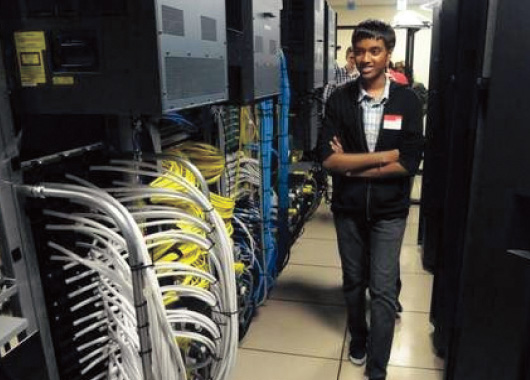Students Bring New Blood to Venerable IBM Units

Sushain Cherivirala, 15, of Sugar Land, Texas, a student at Dulles High School and a winner of IBM’s Master the Mainframe competition takes a tour at IBM’s facility in the Town of Poughkeepsie. Karl Rabe/Poughkeepsie Journal
POUGHKEEPSIE (Poughkeepsie Journal): A new generation of tech students is learning how to use a computer that has been a key part of IBM Corp.’s business since long before they were born.
Five of those students visited Poughkeepsie — a prize they won in IBM’s Master the Mainframe contest.
The local plant is still making mainframe computers, 20 years after some industry analysts were tooting, “The mainframe is dead.” Next year, the venerable platform observes its 50th anniversary.
What about the people? Anybody left who knows how to run the mainframe? Program it? Put an expanding variety of new applications on it?
Not to worry. Young people are being introduced to that as the older generation ages into retirement. The mainframe contest is part of IBM’s Academic Initiative. No experience is needed, just an aptitude.
Miles Nosler of Texas State University in San Marcos, who took first place in the contest, said, “I kind of knew what a mainframe was” but, undaunted, jumped in anyway. He described three levels of challenge in the self-guided test that asks the students to solve computer problems using a mainframe.
“It’s up to you to kind of solve it the best way,” he said.
For IBM, this is not about games.
“This is really about building skills for IBM customers,” said Michael Todd, an IBMer who has run the contest for all of its eight years. The idea is to keep the pipeline of tech talent filled so that the big companies, agencies and universities that buy these “enterprise class” computers can hire help who know what to do with them.
It’s not games for the students, either, as they consider careers. All the winners are thinking of working in information technology.
The top three winners were Nosler; Benjamin Paul, Rose-Hulman Institute of Technology, Terre Haute, Ind., second place; and Sushain Cherivirala, Dulles High School, Sugar Land, Texas, third place.
Cherivirala is a sophomore.
“Ever since fifth grade, I’ve been interested in computers,” he said. He tried the contest last year but didn’t do too well.
So this year he tried again.
Most entrants got word of the contest through their teachers.
“I heard about it in high school,” Paul said.
The contest has grown steadily, Todd said. This year, more than 4,600 students from North America participated and 13,813 globally, from 33 countries.
Argentina was one.
Nahuel Tori of the University of Buenos Aires won a trip to Poughkeepsie. He’s already done work on a mainframe and said, “In Argentina, it is more common to start working while you are still in school.”
“In Spain, we have a very similar situation,” said Pedro Adan, from Madrid.
There are jobs taking care of mainframes and putting them to work.
Actually, the range of work that the big systems do is expanding, adding cloud computing service, “big data” and analytics projects and social business. They’re also in the background for the rising use of mobile devices such as smartphones and tablets.
Mainframes are known as “enterprise” systems, meaning they are most commonly used in large businesses, agencies and universities.
IBM says 96 of the top 100 banks globally use System z.
IBM traces the birth of the line back 49 years and through numerous evolutions and names. That development continues today, with Poughkeepsie being a central point for the work.
Mainframes are thus a large part of the Dutchess County economy, with most of the roughly 8,000 IBMers locally connected to them in some way. The microchips in them come from IBM’s East Fishkill plant.
Mainframes also are manufactured in Singapore.
IBM maintains a jobs board called Systemzjobs.com.
It links clients and students to show job opportunities. So far, 4,300 students have registered, and it regularly posts more than 1,000 mainframe-related jobs, IBM said.
The students got a detailed tour of Poughkeepsie’s manufacturing floors, talks from IBM specialists, including Distinguished Engineer Charles Webb and a tour of IBM’s Green Data Center.
The last is a project in which IBM took a small data center in Building 710 on the north end of the campus and rebuilt it to save energy and develop concepts it could then sell to clients.
Christy Schroeder, an IBM specialist who briefs clients who visit the center, conducted the tour. She said they needed to add capacity but were running out of power and heat loads were exceeding specifications.
“We decreased our power consumption by 50 percent and doubled our capacity … without adding additional cooling,” she said.
Some of the big boxes are now water-cooled, a recent revival of an old IBM technology made necessary again because the chips inside are more powerful and run hotter.
The mainframe is still evolving. It will still need people to run them.
